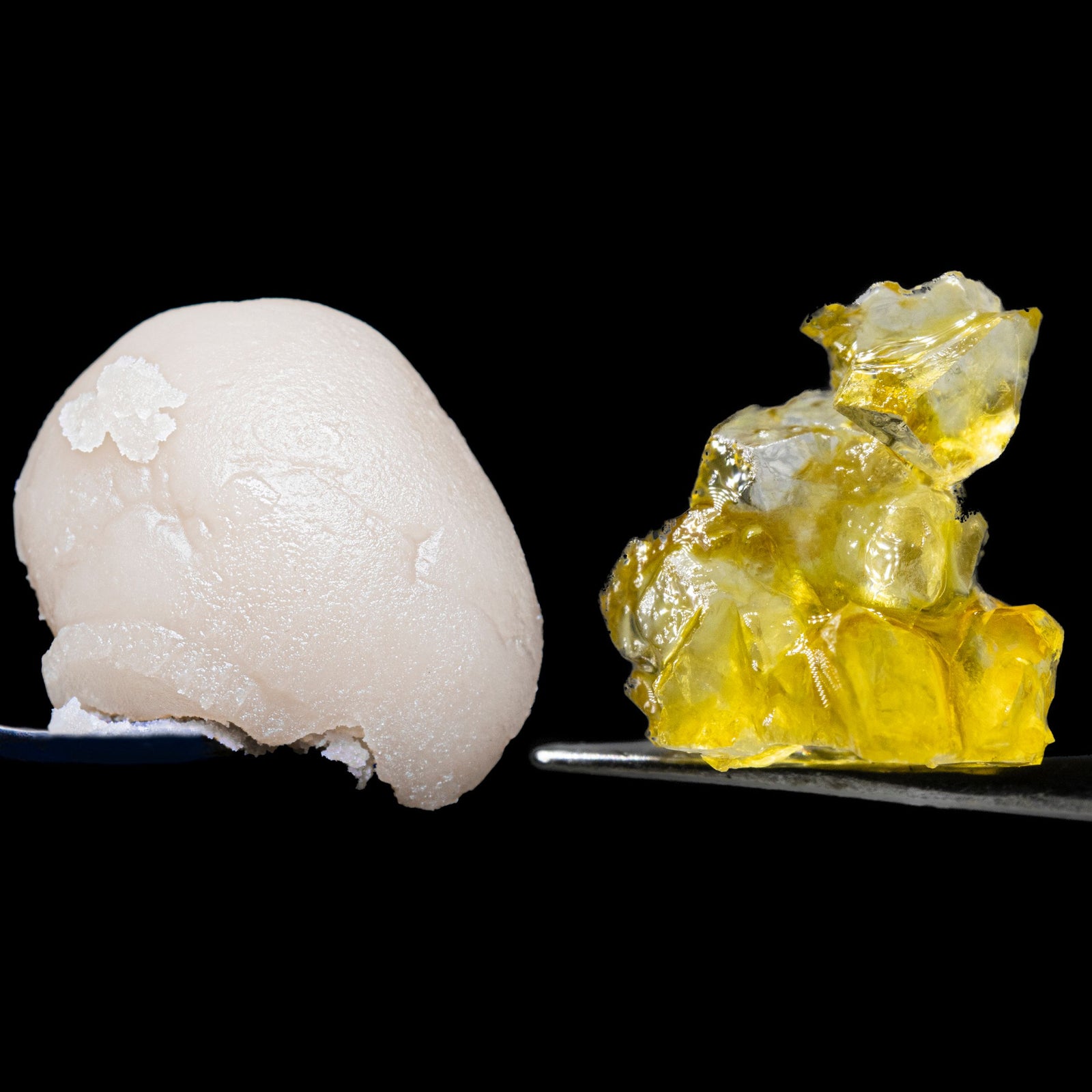BHO vs Rosin - Comparing Solventless & Solvent Extracts

Concentrate manufacturers have two main options when it comes to making cannabis concentrates: butane hash oil (BHO) and rosin. Butane hash oil is a cannabis extract that's made with hydrocarbons such as butane. Rosin is extracted by applying heat and pressure to flower, kief, or bubble hash to release the desirable compounds mechanically.

Solventless extraction—in the form of hash and kief—is the original approach to creating cannabis concentrates. In fact, according to an article in The Seattle Times, the first European records of hash-making are over 200 years old. And while BHO came onto the scene a few years before pressed rosin (1999 compared to 2005), the results when using the latest professional solventless rosin presses are comparable to hydrocarbon extracts in terms of both precision and versatility.
Key Differences Between Butane Hash Oil and Rosin that Cannabis Processors Need to Know
While rosin and BHO can both contain up to 80% THC (sometimes more) and can both be dabbed or vaped, the production process, production costs, and consumer perceptions of each kind of extract differ in several important ways.
Production Process
Butane hash oil is an extract that's created with chemical solvents whereas rosin is an extract that only uses heat and pressure to release the cannabinoids and terpenes from your starting material.
BHO Extraction Process
To produce BHO:
- The plant material is placed in a dedicated column and chilled.
- A solvent, such as butane, is passed through the plant material, dissolving the resin and separating it from the plant matter.
- The cannabis concentrate drips out of the bottom of the column through a filter and is collected. The butane is collected for reuse.
- The extract is purged using a vacuum chamber to remove all of the residual solvent. This process can take a couple of days.
- The extract may then be winterized or further processed to create a range of different textures.
Rosin Extraction Process
To produce rosin:
-
Dried bubble hash, dry sift, or cannabis flower is placed inside one or two rosin bags.

- After folding over the end of the bag(s), the packet is placed inside folded parchment paper and placed between the plates of a rosin press.
- The plates are heated to the appropriate rosin press temperature and pressure is applied using a manual, hydraulic, or pneumatic pump.
- The trichome heads melt and the filtered resin (rosin) flows out from between the plates and runs down the parchment paper.
- The rosin is collected and jarred or processed further with whipping, cold curing, or warm curing to create a range of different textures.
Set-Up Costs
To make BHO, producers will typically spend amounts in the mid-five-figure to six-figure range to purchase a closed-loop extraction system. They will then need to pay for equipment certifications, professional inspections, solvent extraction permits, hazardous substance placards, solvents, safety training for staff, and safety equipment like hydrocarbon detectors, a hazard exhaust system, and personal protective equipment (PPE) for lab personnel.
To make rosin, you will need solventless extraction equipment including a rosin press—which typically costs a few thousand dollars for a high-end professional model, a pump (manual, hydraulic, or pneumatic), and rosin accessories such as rosin bags and parchment paper. No special safety equipment is required—besides a regular amount of common sense (i.e. don't touch the plates while they're hot)—and you don't need any special inspections or permits beyond your state's licensing requirements for commercial cannabis concentrate production.
Safety

Solventless extraction methods are much safer than BHO extraction methods because you're not working with substances that could ignite or explode. While a closed-loop solvent extraction system with safety valves, detectors, ventilation, and PPE is "safe," a simple mistake could do away with your facility, as happened with a backyard operation near Lowell in January 2023.
In contrast, the main risk with rosin extraction is the risk of burns from the heated plates. However, as long as you follow the steps in order (i.e. introduce the filled rosin bag and folded parchment paper before you heat the plates), the risk of an accident is very low.
Production Time
Rosin is slightly quicker to produce than BHO because no post-extraction purging is required. If you wash your plant material to make bubble hash before pressing (most people do), the entire rosin extraction process takes just over a day: 3-4 hours for washing, 24 hours for drying, and 15 minutes for pressing. BHO production typically takes 48 hours, including purging.
Where the BHO extraction method compensates for the slightly longer production time is in the producer's ability to process larger quantities of cannabis material per run. However, solventless extractors can build systems with a comparable processing power using our proprietary Medusa System, which involves several rosin presses connected in series.
Quality and Yield
Both hydrocarbon and solventless extraction methods can produce very high-quality cannabis concentrates if high-quality, fresh cannabis material is used and the extracts are appropriately filtered and/or purged. Both extraction methods can also be used to create "live" extracts using fresh-frozen cannabis as the starting material (for rosin, the fresh-frozen cannabis needs to be washed and the ice water hash dried before pressing).
With some solventless yields breaking 6-8% to rosin from fresh frozen material, solvent extracts still have a leg up on total yield. Butane extracts can come in around 10-12%, even with poor quality material. However, if you do opt for solventless extraction, keep in mind that there are ways to increase your yield in terms of total SKUs. Any resin that’s left over after rosin pressing can be extracted by decarbing the rosin pucks in oil. The infused oil can then be used to make cannabis edibles or topicals.
Diversity of SKUs
Both BHO and rosin can be used to create a wide variety of textures and consistencies depending on the starting material, extraction parameters, and post-processing techniques.
You can process both BHO and rosin into:
- Badder
- Budder
- Wax
- Shatter
- Jam
- Sauce and diamonds
- THCa isolate
- Cannabis oil for vape cartridges
- Edibles
- Topicals
Retail Value
In the eyes of cannabis connoisseurs, solventless extracts like rosin are considered to be superior to BHO because they're made without chemical solvents and, as such, are thought to be "cleaner" and healthier and therefore worth paying a premium for.
Furthermore, considering that the quality of rosin is a direct reflection of the starting material (mold and bacteria aren't "purged" out after pressing, and terpenes aren't added back in), consumers have greater confidence that they're getting the best of the best.
Price per Gram

The higher perceived quality of rosin is reflected in the retail price. As of 2023, the retail value of rosin is around $50-$90 per gram in Denver, significantly higher than BHO, which sits at around $15 to $20 per gram.
Even with a fairly dramatic price compression in the dabbables category from 2022 to 2023, the average price of rosin has remained 45% higher than the average price of dabbables across key recreational states, making rosin a relatively reliable investment in a market that is constantly changing.
Rosin vs BHO ROI
Ultimately, the most accurate way to calculate the relative return on investment (ROI) for rosin vs BHO is to use our rosin profit calculator. By inputting several key variables, you can work out your potential daily net profit if you were to focus on rosin. You can then compare this with your current (or potential) earnings with butane hash oil.
Rosin vs BHO - The Decision Is Becoming Increasingly Clear
Initially, BHO extraction permitted processors to achieve higher yields and a wider variety of products compared to early rosin extraction methods. However, thanks to advances in rosin press tech over the past few years—such as commercial-scale extraction systems and experimentation with post-processing techniques—solventless processors can now achieve comparable results with a lower initial investment and higher potential returns.
If you have a large budget, the know-how to use a closed-loop extraction system safely, and want to produce cannabis concentrates en masse, it might make sense to go with BHO. However, if your goal is to create and market a line of premium-quality, clean, artisan extracts that will maintain their value in a fluctuating market, rosin stands head and shoulders above the rest.



